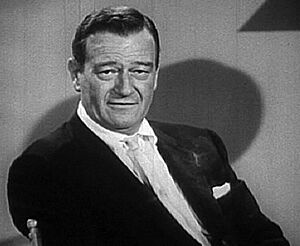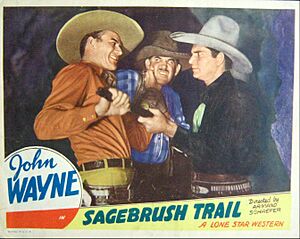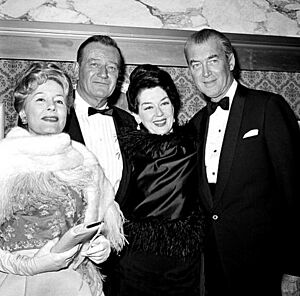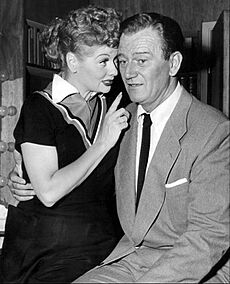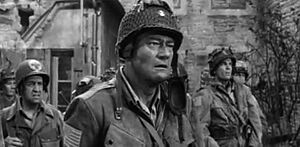John Wayne facts for kids
Quick facts for kids
John Wayne
|
|
|---|---|
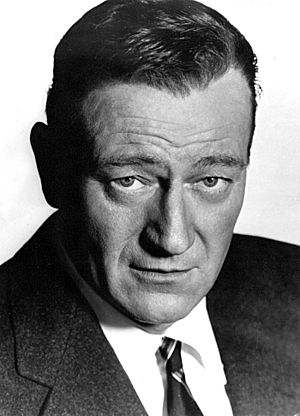
Wayne c. 1965
|
|
| Born |
Marion Robert Morrison
May 26, 1907 Winterset, Iowa, U.S.
|
| Died | June 11, 1979 (aged 72) Los Angeles, California, U.S.
|
| Resting place | Pacific View Memorial Park |
| Other names |
|
| Alma mater | University of Southern California |
| Occupation |
|
| Years active | 1926–1979 |
| Political party | Republican |
| Spouse(s) |
Josephine Saenz
(m. 1933; div. 1945)Esperanza Baur
(m. 1946; div. 1954) |
| Children | 7, including Michael, Patrick, and Ethan |
| Awards | Presidential Medal of Freedom Congressional Gold Medal Hollywood Walk of Fame |
| Signature | |
 |
|
Marion Robert Morrison (born May 26, 1907 – died June 11, 1979) was an American actor. He was known professionally as John Wayne and nicknamed "the Duke". He became a very famous actor, especially for his roles in Western and war movies. These films were made during a special time in Hollywood, often called the Golden Age.
His acting career lasted a long time, from the 1920s when movies didn't have sound, all the way through the 1970s. He appeared in 179 movies and TV shows. For three decades, he was one of the most popular actors at the box office. He worked with many other big Hollywood stars. In 1999, the American Film Institute named him one of the greatest male stars in classic American cinema.
John Wayne was born in Winterset, Iowa, but he grew up in Southern California. He went to the University of Southern California on a football scholarship. However, he lost it after a bodysurfing accident. After that, he started working for Fox Film Corporation. He mostly had small roles at first.
His first main role was in Raoul Walsh's Western movie The Big Trail (1930). This was an early widescreen movie, but it didn't do well at the box office. During the 1930s, he played lead roles in many low-budget Westerns. But he didn't become a huge star until John Ford's Stagecoach (1939). Overall, he starred in 142 movies. Many people felt that John Wayne represented the spirit of the American frontier.
Some of his other famous Western roles include a cattleman in Red River (1948). He also played a Civil War veteran whose niece is taken by Comanches in The Searchers (1956). In True Grit (1969), he played a tough one-eyed marshal named Rooster Cogburn. For this role, he won an Academy Award for Best Actor.
Wayne is also remembered for movies like The Quiet Man (1952) with Maureen O'Hara. He starred in Rio Bravo (1959) with Dean Martin. Another famous film was The Longest Day (1962). His last movie was The Shootist (1976), where he played an old gunfighter battling cancer. John Wayne made his last public appearance at the Academy Awards on April 9, 1979. He died of stomach cancer two months later. In 1980, he was given the Presidential Medal of Freedom after his death. This is the highest award a civilian can receive in the United States.
Contents
Early Life and Nickname
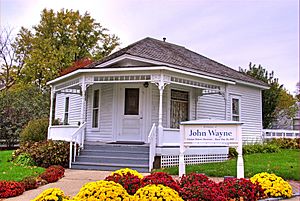
John Wayne was born Marion Robert Morrison on May 26, 1907. He was born at 224 South Second Street in Winterset, Iowa. The local newspaper reported that he weighed about 6 kilograms (13 pounds) at birth. Wayne said his middle name was changed to Michael. However, his legal name remained Marion Robert Morrison throughout his life.
Wayne's father was Clyde Leonard Morrison. His mother was Mary "Molly" Alberta Brown. John Wayne had Scottish, Scotch-Irish, English, and Irish family roots. His family came from places like Ireland and Scotland. He grew up following the Presbyterian faith.
His family moved to Palmdale, California, and then to Glendale in 1916. His father worked as a pharmacist there. John Wayne went to Glendale Union High School. He was good at both sports and schoolwork. He played on the football team and was part of the debating team. He was also the president of the Latin Society and wrote for the school's sports newspaper.
A local fireman started calling him "Little Duke." This was because John Wayne always had his large Airedale Terrier dog, Duke, with him. He liked the name "Duke" better than "Marion," and the nickname stayed with him. As a teenager, he worked at an ice-cream shop. He also played football for the Glendale High School team that won the league championship in 1924.
Wayne wanted to go to the United States Naval Academy, but his grades were not good enough. Instead, he went to the University of Southern California (USC). He studied pre-law and was part of the Trojan Knights and Sigma Chi fraternities. Wayne was very tall, about 6 feet 4.5 inches. He also played on the USC football team. His football career ended when he broke his collarbone in a bodysurfing accident. He lost his sports scholarship and had to leave the university because he didn't have enough money.
Career in Movies
First Roles and Becoming a Star
After leaving college, John Wayne got a job working for the Fox Film Corporation. He was a prop boy and an extra in movies. This happened because his football coach, Howard Jones, was friends with director John Ford and silent film star Tom Mix. Wayne later said that he learned his famous walk and way of talking from Wyatt Earp, who was friends with Tom Mix.
Wayne started getting small parts in movies. He became good friends with John Ford, who gave him many of these roles. In 1926, he had a small, uncredited role as a guard in Bardelys the Magnificent. He also played football with his USC teammates in movies like Brown of Harvard (1926) and Salute (1929).
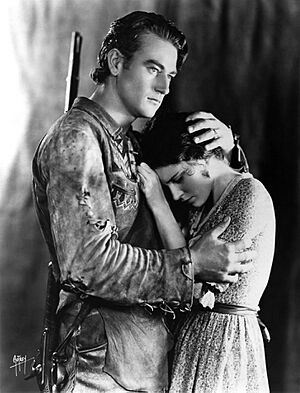
While working for Fox, Wayne was sometimes called "Duke Morrison" on screen. Director Raoul Walsh saw him moving furniture and decided to cast him in his first starring role. This was in The Big Trail (1930). Walsh suggested the screen name "Anthony Wayne" for him. But the head of Fox Studios, Winfield Sheehan, thought it sounded "too Italian." Walsh then suggested "John Wayne," and Sheehan agreed. Wayne wasn't even there for this discussion. His pay was raised to $105 a week.
The Big Trail was a big-budget outdoor movie for its time, costing over $2 million. It used many extras and showed wide views of the American Southwest. It was filmed in two versions, including a new widescreen process. Many people who saw it in widescreen loved it. However, only a few theaters could show the widescreen version, so the movie was not a big success at the time. Today, critics think it's a very good film.
Later Films and World War II
After The Big Trail didn't do well, Wayne mostly got small roles in bigger movies. He also starred in many low-budget Westerns, sometimes called "horse operas." He made about 80 of these movies between 1930 and 1939. In Riders of Destiny (1933), he even became one of the first "singing cowboys," though someone else sang his songs.

Stuntmen taught Wayne how to ride horses and other Western skills. He and stuntman Yakima Canutt created new ways to do stunts and fight scenes that are still used today. Wayne changed how heroes fought in Westerns. He said, "Before I came along, the hero always had to fight clean. I changed all that. I fought hard and I fought dirty. I fought to win."
John Wayne's big breakthrough came with John Ford's Stagecoach (1939). Because Wayne had been in so many low-budget movies, Ford had trouble getting money for this film. But Stagecoach was a huge success with both critics and audiences. John Wayne became a major star.
When World War II began, many people in Hollywood supported the war effort. John Wayne was not required to serve in the military because of his age (34) and family. He was classified as 3-A, meaning he had a family deferment. Wayne wanted to join the military and even wrote to John Ford about it. However, Republic Studios, where he had a contract, did not want to lose their only big star. They asked for him to be deferred from service.
Records show that Wayne did apply to serve in the Office of Strategic Services (OSS), which was like an early version of the CIA. But his application was not successful. He did tour U.S. military bases and hospitals in the South Pacific for three months in 1943 and 1944. He was part of the USO, which entertains troops. During this trip, he also helped the OSS by checking on their work. The head of the OSS later gave Wayne a certificate for his help.
Some people believe that not serving in the military was a very difficult part of his life. His wife later said that his strong patriotism in later years came from feeling guilty about not serving.
Wayne's first color movie was Shepherd of the Hills (1941). He also starred in Reap the Wild Wind (1942), directed by Cecil B. DeMille. This was one of the few times he played a character who wasn't entirely good.
Like many stars, Wayne appeared on radio shows. He often recreated his movie roles for radio programs. For six months in 1942, he starred in his own radio adventure series called Three Sheets to the Wind. He played a detective named Dan O'Brien.
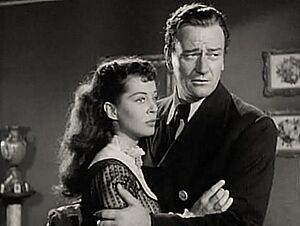
Director Robert Rossen offered Wayne the main role in All the King's Men (1949). But Wayne turned it down because he felt the script was "un-American." The actor who took the role, Broderick Crawford, won an Oscar for it.
The 1950s and Beyond
Wayne turned down the lead role in The Gunfighter (1950). He didn't want to work for Columbia Pictures because their boss had treated him badly years before. Even though he really wanted the role, he wouldn't work for that studio.
In 1952, Wayne started his own movie production company called Batjac. He produced many films through this company, both for himself and other actors. One of his most popular roles was in The High and the Mighty (1954). He played a heroic co-pilot, and his performance was highly praised. He also played pilots in several other movies, such as Flying Tigers (1942) and Flying Leathernecks (1951).
He worked with director John Ford on almost two dozen films over 20 years. These include She Wore a Yellow Ribbon (1949) and The Quiet Man (1952). Many people think his best and most complex acting was in Ford's The Searchers (1956). This was the first movie where he called someone "Pilgrim."
In 1958, Wayne had a small cameo role as himself in I Married a Woman. He also starred in The Barbarian and the Geisha, where he often disagreed with the director.
Howard Hawks's Rio Bravo came out in 1959. Wayne played the lead role with Dean Martin and Ricky Nelson. He also starred with William Holden in John Ford's The Horse Soldiers, a Civil War movie.
Wayne played Genghis Khan in The Conqueror (1956), which critics did not like.
The 1960s
In 1960, John Wayne directed and produced The Alamo, where he played Davy Crockett. He was nominated for an Oscar as a producer for Best Picture. He also starred in North to Alaska and The Comancheros.
In 1962, Wayne starred with James Stewart in John Ford's The Man Who Shot Liberty Valance. He also appeared in Hatari!, filmed in Africa, where he captured wild animals. In The Longest Day, he was part of a large cast of stars. He was paid a lot more than the other actors in that film due to an earlier disagreement with the producer.
In 1963, Wayne was in a part of How the West Was Won. He also starred in his last John Ford film, Donovan's Reef, with Lee Marvin. Later that year, he was in McLintock! with Maureen O'Hara.
In 1965, Wayne had a small role as a centurion in The Greatest Story Ever Told. He also starred with Kirk Douglas in In Harm's Way and with Dean Martin in The Sons of Katie Elder.
In 1967, Wayne starred in The War Wagon with Kirk Douglas. His other movie that year was El Dorado, which was a successful remake of Rio Bravo.
In 1968, Wayne co-directed The Green Berets with Ray Kellogg. This was the only major film made during the Vietnam War that supported the war. Wayne wanted to make this movie because Hollywood wasn't interested in Vietnam War films at the time. During filming, the Montagnard people of Vietnam gave Wayne a brass bracelet. He wore it in this movie and all his later films. He also starred in Hellfighters, about oil rig firefighters.
In 1969, True Grit premiered. John Wayne won the Academy Award for Best Actor for his role as Rooster Cogburn. He also starred in The Undefeated with Rock Hudson.
The 1970s: Later Career
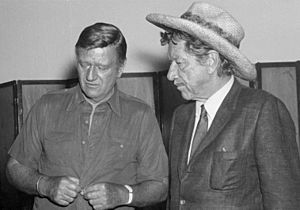
In 1970, John Wayne starred in Chisum, playing a cattle ranch owner. He also appeared in Howard Hawks' Rio Lobo, another remake of Rio Bravo.
In 1971, Big Jake was released. Wayne played a father who has to find a gang that kidnapped his grandson. This film was very popular and received good reviews.
In 1972, Wayne starred in The Cowboys. A film critic from The New York Times said that Wayne was "marvelously indestructible" and a "perfect father figure" in the movie. That same year, the Atlanta Falcons football team tried to draft him for his past football experience. However, the league didn't allow it because he was 64 years old.
In 1973, Wayne starred in The Train Robbers with Ann-Margret. He also appeared in Cahill U.S. Marshal, which was not a box office success.
In 1974, Wayne played a detective in the crime drama McQ.
In 1975, he starred in Brannigan, playing a Chicago police lieutenant in London. He also reprised his role as Rooster Cogburn in Rooster Cogburn, starring with Katharine Hepburn.
In 1976, Wayne starred in The Shootist. This was his last movie role. In the film, his character, J. B. Books, was dying of cancer. John Wayne himself died of cancer three years later. The movie received good reviews and was named one of the Ten Best Films of 1976 by the National Board of Review.
Personal Life
John Wayne was married three times and divorced twice. His wives were Josephine Alicia Saenz, Esperanza Baur, and Pilar Pallete. He had four children with Josephine: Michael Wayne (1934–2003), Mary Antonia "Toni" Wayne LaCava (1936–2000), Patrick Wayne (born 1939), and Melinda Wayne Munoz (1940–2022). He had three more children with Pilar: Aissa Wayne (born 1956), John Ethan Wayne (born 1962), and Marisa Wayne (born 1966).
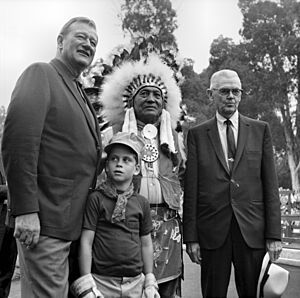
Several of his children also worked in the film and television industry. His son Ethan was sometimes called John Ethan Wayne in movies. He also played a main role in the 1990s TV series Adam-12. Ethan has appeared on the History Channel show Pawn Stars to help check if items related to his father were real. His granddaughter Jennifer Wayne is a member of the country music group Runaway June.
In 1973, his wife Pilar, who loved tennis, encouraged him to build the John Wayne Tennis Club in Newport Beach, California. In The Quiet Man (1952), Wayne's character says he is six feet "four and a half" inches tall. His wife Pilar confirmed this in her book about him.
John Wayne was a chess player. He often used the same 1873 Colt Single Action Army revolver in many of his Western movies.
He was diagnosed with lung cancer in 1964. He had surgery to remove his entire left lung and two ribs. Even though his business partners wanted him to keep his illness private, Wayne announced he had cancer. He encouraged the public to get regular health check-ups. Five years later, he was declared cancer-free.
John Wayne was a Freemason. He was a Master Mason in a lodge in Tucson, Arizona. He also joined other Masonic groups. In the early 1960s, Wayne often traveled to Panama. He bought the island of Taborcillo off Panama's Pacific coast. His family sold it after he died.
Wayne's yacht, the Wild Goose, was one of his favorite possessions. He kept it docked in Newport Beach Harbor. In 2011, it was added to the U.S. National Register of Historic Places.
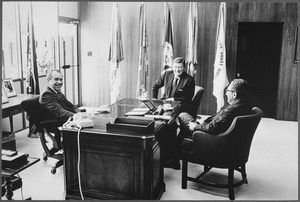

Death
John Wayne died of stomach cancer on June 11, 1979. He passed away at the UCLA Medical Center. He was buried in the Pacific View Memorial Park Cemetery in Corona del Mar, Newport Beach. His son Patrick and grandson Matthew Muñoz said that Wayne converted to Roman Catholicism shortly before he died.
He asked for his tombstone to read "Feo, Fuerte y Formal". This is a Spanish phrase that Wayne said meant "ugly, strong, and dignified." His grave was unmarked for 20 years. Since 1999, it has a quote that says:
Tomorrow is the most important thing in life. Comes into us at midnight very clean. It's perfect when it arrives and it puts itself in our hands. It hopes we've learned something from yesterday.
Acting Style
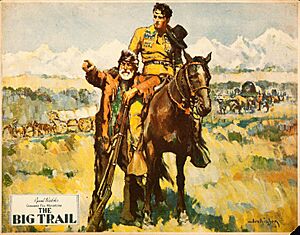

In 1974, film critic Charles Champlin wrote that John Wayne was a true movie actor. He said Wayne had a strong presence that always came through on film. Director John Ford said that Wayne was "real, perfectly natural." He wasn't like actors who follow strict acting rules.
Wayne saw himself as someone who reacted rather than just acted. He believed that good acting meant reacting in a logical way to a situation. This helps the audience connect with the characters. He said, "I read dramatic lines undramatically and react to situations normally. This is not as simple as it sounds."
Howard Hawks, who directed Wayne in five films, felt that Wayne became an even better actor after he lost a lung. Hawks explained that Wayne would pause in unusual places because he didn't have as much breath. This made his acting very effective.
Some critics said Wayne often played the same type of character. But Wayne disagreed. He said people forgot how different his roles were in movies like The Quiet Man or Iwo Jima. He believed that to stay a star, an actor needs to bring some of their own personality to a role. Actor Gene Hackman said that Wayne "was one of the best actors ever." He admired Wayne's command of a scene and his great charisma.
Legacy and Honors
John Wayne is remembered as an American icon. He represented American values and ideals. Through his movies and radio shows, he helped create a shared national culture. As his career went on, he chose roles that fit his strong public image. He became a symbol of American masculinity and independence.
His image as a war hero grew after Sands of Iwo Jima (1949). His footprints at Grauman's Chinese theater in Hollywood even contain sand from Iwo Jima. When Japanese Emperor Hirohito visited the U.S. in 1975, he asked to meet John Wayne. This showed how important Wayne was as a symbol of America. Similarly, when Soviet leader Nikita Khrushchev visited in 1959, he wanted to meet Wayne.
John Wayne was one of the top money-making stars for many years. He appeared in the Top Ten Money Makers Poll of all films from 1949 to 1957 and from 1958 to 1974. He was in first place in 1950, 1951, 1954, and 1971. With 25 years on the list, he has been on it more than any other star.
He is also the only actor to appear in every annual Harris Poll of Most Popular Film Actors. He is also the only actor to appear on the list after his death. He was in the top 10 for 19 years in a row, starting 15 years after he died.
Awards and Landmarks
The U.S. government recognized John Wayne with two of its highest civilian awards. On his 72nd birthday, May 26, 1979, he received the Congressional Gold Medal. Many Hollywood stars and leaders supported this award. Robert Aldrich, president of the Directors Guild of America, spoke in favor of it. He said that even though he was a Democrat and didn't share Wayne's political views, Wayne deserved the award for his courage, dignity, and talent.
After his death, on June 9, 1980, President Jimmy Carter awarded him the Presidential Medal of Freedom.
Many public places are named after John Wayne. These include the John Wayne Airport in Orange County, California. A 9-foot bronze statue of him on a horse stands at the airport entrance. There's also the John Wayne Marina near Sequim, Washington, on land he donated. John Wayne Elementary School (P.S. 380) in Brooklyn, New York, has a large mosaic mural of him. Over 100 miles of trail in Washington's Iron Horse State Park are named the "John Wayne Pioneer Trail."
In 2006, friends of Wayne started the "Louie and the Duke Classics" events. These events raise money for the John Wayne Cancer Foundation and the American Cancer Society.
On May 26, 2007, the 100th anniversary of Wayne's birth, many celebrations took place. At his birthplace in Winterset, Iowa, there were concerts and a Cowboy Symposium with people who worked with him. Ground was broken for the new John Wayne Birthplace Museum and Learning Center. Later that year, California Governor Arnold Schwarzenegger inducted Wayne into the California Hall of Fame.
In 2016, a politician proposed making May 26 "John Wayne Day" in California. However, this idea was voted down.
John Wayne Cancer Foundation
The John Wayne Cancer Foundation was started in 1985. It honors John Wayne and continues the fight against cancer. The foundation's goal is to "bring courage, strength, and grit to the fight against cancer." It provides money for programs that help cancer patients, including research, education, and support.
Dispute with Duke University
John Wayne Enterprises, a business run by Wayne's family, sells products like Bourbon whiskey. They use the "Duke" brand and Wayne's picture. When the company tried to trademark the image, Duke University in North Carolina objected. The university said they didn't want the company to trademark the name "Duke" without Wayne's image. A judge later dismissed the company's lawsuit.
Filmography
Between 1926 and 1977, John Wayne appeared in over 170 films. He was named the top money maker in polls as of 2005.
Roles He Didn't Take
- Wayne turned down the main role in the 1952 film High Noon. He felt the movie's story was against his beliefs. He later said he considered High Noon "the most un-American thing I've ever seen."
- It's a popular story that in 1955, Wayne turned down the role of Matt Dillon in the TV series Gunsmoke. He supposedly recommended James Arness instead. While he did suggest Arness and introduced him in the first episode, a movie star of Wayne's fame would not have considered a TV role at that time.
- The role of Major T. J. "King" Kong in Dr. Strangelove (1964) was first thought of for Wayne. Director Stanley Kubrick offered him the part, but Wayne immediately turned it down. He was replaced by Slim Pickens.
- In 1966, Wayne accepted the role of Major Reisman in The Dirty Dozen (1967). But he later left the project to make The Green Berets. Lee Marvin took his place.
- Wayne wanted the main role in Dirty Harry (1971). However, Warner Bros. decided he was too old at 63. They cast the 41-year-old Clint Eastwood instead.
- In the early 1970s, Wayne was offered the lead role in Michael Cimino's Heaven's Gate (1980). Ironically, Wayne later presented the Best Picture Oscar to Cimino for The Deer Hunter (1978).
- Director Peter Bogdanovich and writer Larry McMurtry planned a film in 1971 called The Streets of Laredo. It would star Wayne, James Stewart, and Henry Fonda. Wayne turned it down because he felt his character wasn't interesting enough. This project was later rewritten into the famous novel and TV series Lonesome Dove.
- Mel Brooks offered Wayne the role of the Waco Kid in Blazing Saddles (1974). Wayne read the script but declined. He felt the dialogue was "too dirty" for his family-friendly image. But he told Brooks he would be "first in line" to see the movie.
- Steven Spielberg offered Wayne a role in the film 1941. Wayne decided not to participate due to his health. He also told Spielberg not to make the movie. Wayne felt the film was "unpatriotic" and made fun of World War II.
Awards and Nominations
Academy Awards
| Year | Work | Category | Result |
|---|---|---|---|
| 1949 | Sands of Iwo Jima | Best Actor | Nominated |
| 1960 | The Alamo | Best Picture | Nominated |
| 1969 | True Grit | Best Actor | Won |
Golden Globe Awards
| Year | Work | Category | Result |
|---|---|---|---|
| 1953 | N/A | Henrietta Award (World Film Favorite – Male) | Won |
| 1966 | N/A | Cecil B. DeMille Award | Honored |
| 1970 | True Grit | Best Actor – Motion Picture Drama | Won |
Grammy Awards
| Year | Work | Category | Result |
|---|---|---|---|
| 1972 | America, Why I Love Her | Best Spoken Word Album | Nominated |
Brass Balls Award
In 1973, The Harvard Lampoon, a student newspaper at Harvard University, invited Wayne to receive "The Brass Balls Award." They created this award in his "honor." Wayne accepted the invitation to promote his movie McQ. The ceremony was held on January 15, 1974. Wayne received a standing ovation from the audience when he walked onto the stage.
Additional Awards and Honors
- 1960: Received a star on the Hollywood Walk of Fame at 1541 Vine Street for his work in movies.
- 1970: Received the DeMolay Legion of Honor.
- 1970: Received the Golden Plate Award from the American Academy of Achievement.
- 1973: Awarded the Gold Medal from the National Football Foundation.
- 1974: Inducted into the Hall of Great Western Performers in the National Cowboy and Western Heritage Museum.
- 1978: Received the Omar Bradley Spirit of Independence Award.
- 1979: Received the Congressional Gold Medal.
- 1980: Awarded the Presidential Medal of Freedom, the nation's highest civilian honor, by President Jimmy Carter.
- 1986: Inducted into the DeMolay Hall of Fame.
Images for kids
-
Lobby card for The Big Trail (1930)
-
With Jean Rogers and Ward Bond in Conflict (1936)
-
With Joan Blondell in Lady for a Night (1942)
See also
 In Spanish: John Wayne para niños
In Spanish: John Wayne para niños
- Hall of Great Western Performers
- List of film director and actor collaborations
- List of famous amateur chess players
- List of Freemasons
- National Cowboy & Western Heritage Museum
- John Wayne filmography




